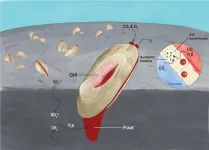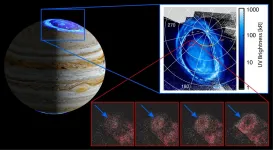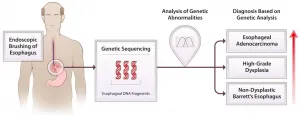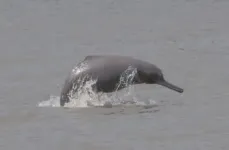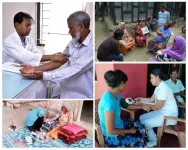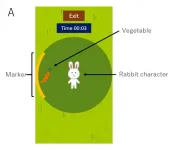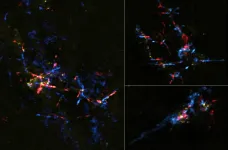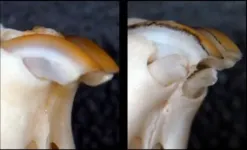(Press-News.org) A study led by scientists at Hong Kong Baptist University (HKBU) has decoded the genomes of the deep-sea clam (Archivesica marissinica) and the chemoautotrophic bacteria (Candidatus Vesicomyosocius marissinica) that live in its gill epithelium cells. Through analysis of their genomic structures and profiling of their gene expression patterns, the research team revealed that symbiosis between the two partners enables the clams to thrive in extreme deep-sea environments.
The research findings have been published in the academic journal Molecular Biology and Evolution.
Due to the general lack of photosynthesis-derived organic matter, the deep-sea was once considered a vast "desert" with very little biomass. Yet, clams often form large populations in the high-temperature hydrothermal vents and freezing cold seeps in the deep oceans around the globe where sunlight cannot penetrate but toxic molecules, such as hydrogen sulfide, are available below the seabed. The clams are known to have a reduced gut and digestive system, and they rely on endosymbiotic bacteria to generate energy in a process called chemosynthesis. However, when this symbiotic relationship developed, and how the clams and chemoautotrophic bacteria interact, remain largely unclear.
Horizontal gene transfer between bacteria and clams discovered for the first time
A research team led by Professor Qiu Jianwen, Associate Head and Professor of the Department of Biology at HKBU, collected the clam specimens at 1,360 metres below sea level from a cold seep in the South China Sea. The genomes of the clam and its symbiotic bacteria were then sequenced to shed light on the genomic signatures of their successful symbiotic relationship.
The team found that the ancestor of the clam split with its shallow-water relatives 128 million years ago when dinosaurs roamed the earth. The study revealed that 28 genes have been transferred from the ancestral chemoautotrophic bacteria to the clam, the first discovery of horizontal gene transfer--a process that transmits genetic material between distantly-related organisms --from bacteria to a bivalve mollusc.
The following genomic features of the clam were discovered, and combined, they have enabled it to adapt to the extreme deep-sea environment:
(1) Adaptions for chemosynthesis
The clam relies on its symbiotic chemoautotrophic bacteria to produce the biological materials essential for its survival. In their symbiotic relationship, the clam absorbs hydrogen sulfide from the sediment, and oxygen and carbon dioxide from seawater, and it transfers them to the bacteria living in its gill epithelium cells to produce the energy and nutrients in a process called chemosynthesis. The process is illustrated in Figure 1.
The research team also discovered that the clam's genome exhibits gene family expansion in cellular processes such as respiration and diffusion that likely facilitate chemoautotrophy, including gas delivery to support energy and carbon production, the transfer of small molecules and proteins within the symbiont, and the regulation of the endosymbiont population. It helps the host to obtain sufficient nutrients from the symbiotic bacteria.
(2) Shift from phytoplankton-based food
Cellulase is an enzyme that facilitates the decomposition of the cellulose found in phytoplankton, a major primary food source in the marine food chain. It was discovered that the clam's cellulase genes have undergone significant contraction, which is likely an adaptation to the shift from phytoplankton-derived to bacteria-based food.
(3) Adaptation to sulfur metabolic pathways
The genome of the symbiont also holds the secrets of this mutually beneficial relationship. The team discovered that the clam has a reduced genome, as it is only about 40% of the size of its free-living relatives. Nevertheless, the symbiont genome encodes complete and flexible sulfur metabolic pathways, and it retains the ability to synthesise 20 common amino acids and other essential nutrients, highlighting the importance of the symbiont in generating energy and providing nutrients to support the symbiotic relationship.
(4) Improvement in oxygen-binding capacity
Unlike in vertebrates, haemoglobin, a metalloprotein found in the blood and tissues of many organisms, is not commonly used as an oxygen carrier in molluscs. However, the team discovered several kinds of highly expressed haemoglobin genes in the clam, suggesting an improvement in its oxygen-binding capacity, which can enhance the ability of the clam to survive in deep-sea low-oxygen habitats.
Professor Qiu said: "Most of the previous studies on deep-sea symbiosis have focused only on the bacteria. This first coupled clam-symbiont genome assembly will facilitate comparative studies that aim to elucidate the diversity and evolutionary mechanisms of symbiosis, which allows many invertebrates to thrive in 'extreme' deep-sea ecosystems."
INFORMATION:
The research was jointly conducted by scientists from HKBU and the HKBU Institute for Research and Continuing Education, the Hong Kong Branch of the Southern Marine Science and Engineering Guangdong Laboratory (Guangzhou), The Hong Kong University of Science and Technology, City University of Hong Kong, the Japan Agency for Marine-Earth Science and Technology, the Sanya Institute of Deep-Sea Science and Engineering, and the Guangzhou Marine Geological Survey.
SAN ANTONIO -- March 29, 2021 -- The SwRI-led Ultraviolet Spectrograph (UVS) orbiting Jupiter aboard NASA's Juno spacecraft has detected new faint aurora features, characterized by ring-like emissions, which expand rapidly over time. SwRI scientists determined that charged particles coming from the edge of Jupiter's massive magnetosphere triggered these auroral emissions.
"We think these newly discovered faint ultraviolet features originate millions of miles away from Jupiter, near the Jovian magnetosphere's boundary with the solar wind," said Dr. Vincent Hue, lead author of a paper accepted by the Journal of Geophysical Research: Space Physics. "The solar wind is a supersonic ...
SPOKANE, Wash. - New research led by scientists at Washington State University has found that a protein known as GBP5 appears to play a key role in suppressing inflammation in rheumatoid arthritis, a potentially debilitating disease in which the immune system mistakenly attacks the body's own joint tissues.
Published in the journal Arthritis & Rheumatology, the discovery could someday lead to new treatments to slow or halt the progress of the disease, which affects an estimated 1.5 million Americans. The researchers said it may also have applications in other inflammatory diseases.
First author ...
A combination of esophageal brushing and extensive genetic sequencing of the sample collected can detect chromosome alterations in people with Barrett's Esophagus, identifying patients at risk for progressing to esophageal cancer, according to a new study by researchers at the Johns Hopkins Kimmel Cancer Center and Case Western Reserve University.
In Barrett's Esophagus (BE), chronic acid reflux from the stomach damages the cells lining the lower esophagus, causing them to become more like cells of the lower digestive system. Cells in the lower esophagus progress through several precancerous stages before sometimes developing into esophageal adenocarcinoma, a cancer with a five-year survival rate below 20 percent. BE is the only known precursor to esophageal adenocarcinoma.
Clinicians ...
EU imports of products including palm oil, soybeans, and beef contribute significantly to deforestation in other parts of the world. In a new study, researchers from Chalmers University of Technology, Sweden, and the University of Louvain, Belgium, evaluated over a thousand policy proposals for how the EU could reduce this impact, to assess which would have the largest potential to reduce deforestation - while also being politically feasible.
"Unsurprisingly, there is weaker support for tougher regulations, such as import restrictions on certain goods. But our study shows that there is broad support in general, ...
New genetic analysis and years of painstaking research has revealed that one of the world's most endangered marine mammals is actually two species rather than one, as scientists had long assumed.
Scientists spent about two decades crossing Asia and Europe in pursuit of river dolphins skulls and reexamining tissue samples with modern genetic techniques. Their findings revealed that Indus and Ganges river dolphins are separate species, according to a new study published in Marine Mammal Science.
The two dolphins that live in the muddy waters ...
SINGAPORE, 29 March 2021 - A low-cost intervention to improve hypertension--or high blood pressure (BP)--prevention and management can be cost-effectively scaled up for rural communities in low- and middle-income countries, according to findings from a multi-country trial published in The Lancet Global Health.
Led by Duke-NUS Medical School in Singapore, the Control of Blood Pressure and Risk Attenuation--Bangladesh, Pakistan, Sri Lanka (COBRA-BPS) trial, conducted in partnership with the International Centre for Diarrhoeal Diseases Research, Bangladesh (ICDDR,B), Aga Khan University in Pakistan, the University of Kelaniya in Sri Lanka, analysed the budget impact and cost-effectiveness ...
A Japanese research group combined motion analysis that uses smartphone application and machine learning that uses an anomaly detection method, thereby developing a technique to easily screen for carpal tunnel syndrome. Carpal tunnel syndrome is common amongst middle-aged women. The disease causes compressed nerves in the wrist, causing numbness and difficulty with finger movements. While an accurate diagnosis can be reached with nerve conduction study, this is not widely used because it requires expensive devices and specialized skills. Thus, a simple screen tool that does ...
Astronomers found a number of stellar eggs containing baby stars around the center of the Milky Way using the Atacama Large Millimeter/submillimeter Array (ALMA). Previous studies had suggested that the environment there is too harsh to form stars. These findings indicate that star formation is more resilient than researchers thought.
Stars form in stellar eggs, cosmic clouds of gas and dust which collapse due to gravity. If something interferes with the gravity driven contraction, star formation will be suppressed. There are many potential sources of interference near the Galactic Center. Strong turbulence can stir up the clouds ...
Japan -- The tooth fairy is a welcome guest for any child who has lost a tooth. Not only will the fairy leave a small gift under the pillow, but the child can be assured of a new tooth in a few months. The same cannot be said of adults who have lost their teeth.
A new study by scientists at Kyoto University and the University of Fukui, however, may offer some hope. The team reports that an antibody for one gene -- uterine sensitization associated gene-1 or USAG-1 -- can stimulate tooth growth in mice suffering from tooth agenesis, a congenital condition. The paper was published in Science Advances.
Although the normal adult mouth has 32 teeth, about ...
A group of researchers from Russia, Germany, the Czech Republic, and Switzerland contest the common belief that resource-based economies have higher levels of within-country inequality than resource-scarce economies. The researchers document a direct causal link between natural resources and within-country inequality and conclude that the extraction of oil and gas can reduce inequality or has no significant effect on it. The results were published in the journal Empirical Economics.
"When we compare the natural resource rents to GDP 10 years after the discovery of natural ...
